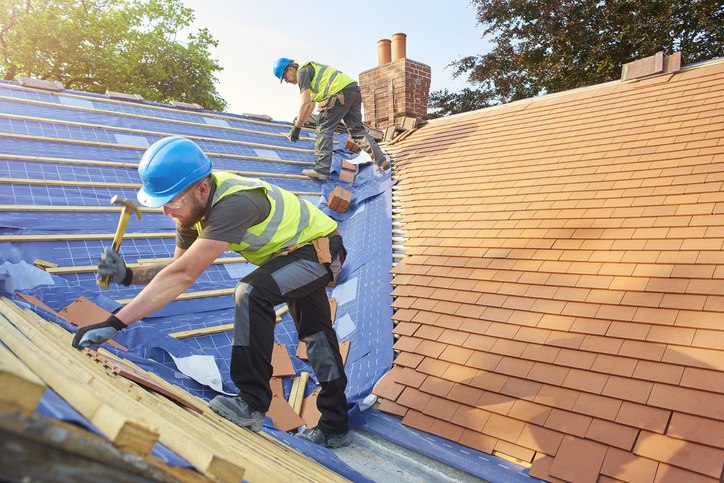We can all agree that the most important part of a house is the roof.
As much as sturdy walls and marble floors are desirable, they stand only as wants to be compared to a good roof. No matter the weather, these overlapping shingles will rest assured, keep your whole house grounded, warm, and dry.

These shingles come in different types, namely asphalt, concrete, vinyl membrane, and even metal roofing, which this article presents as a perfect base for those looking to install solar PVs. Surprisingly, this type of roofing will last for 70 long years while the solar PVs’ service life is 37 years on average.
Thus, it is natural to make sure our roofs are still the necessity we need and have not turned into a liability for us, but how would you possibly know if it’s time for a repair, or in major cases, replacement?
This article will talk about the tips to know if your trusty roof has reached its limit.
In relationships, a “red flag” is typically used to talk about danger signs that might pose a problem, causing long-term damage to both your mental health and physiologic wellness. This almost always requires you to leave the relationship instead of fixing it, though there are still relationships that can be salvaged.
The same can be applied to our roofs, which poses more of a disastrous type of danger that may cause bodily harm. How do you know if it’s time to say goodbye to an old roof and hello to a new one, or if it just requires a small fixing?
Read Also:
Curling shingles happen overtime when your roof is already older than 25 years. Other than the inevitable aging, it may happen due to poor workmanship, low-quality shingles installed, a very frigid winter that happened that year, new shingles were installed over old ones, or if there is not enough attic ventilation.
Whatever it is, curling and buckling shingles aren’t great to look at, nor are they a good sign. If you’ve just installed your shingles and curling happens, contact a roofing company such as this one: hcroof.com.au/ located in Newcastle.
Though curling is done by many simply for aesthetic purposes, it may hide more underlying problems you might want to take care of as early as possible.
It may sound alarming to know your roof is having a small dip. You might assume it will all fall on and around you. A sagging roofline may indicate many possibilities, ranging from ones that you can DIY to more serious ones that need a professional.
Rotting sheaths may cause your roof to sag a little and is the easiest to remedy with replacement. More complex problems originate in the fundamentals, such as broken rafters or trusses that may need an expert’s touch.
Shingles are just like the rhinestones covering some dresses. The longer they stay stuck on the material, the more susceptible they are of falling off.
Especially when you begin to use it, the environment (bumping around, the way it is washed, or what detergent is used) will leave you surprised with some missing gaps.
Shingles are the same. Over the years, your roof was exposed to sunlight, harsh winter, storms, and hail, which will cause some to come off.
Though if ever your shingles are missing after a month or two, it may be caused by poor installment, and contacting your roofing company for a warranty is encouraged.
Another indication that your roof is falling apart without looking or climbing up is shingle fragments in your gutters. Usually, shingles crack and break asunder when their service years are coming to a close.
Unless your purchased shingles are cheap, seeing them in your gutter after long years isn’t a surprise. It is a big sign to consider contacting a contractor for that new roof, though.
Any of these two can spell trouble for your roof. Moss grows on any surface that has moisture, meaning it can grow by sidewalks, trees, and yes, even your roof. And where moss grows is likely a place full of trapped moisture.
Knowing more about moss and how they grow will give you an idea of how to prevent them from growing in the first place.
These plants will prove to be the downfall of your roof structure when left alone to grow and multiply. It may cause your sheathe to absorb all that moisture, grow unwanted mold, and weaken it.
Sooner or later it will eat away on trusses or the rafter, and even cause interior damage to walls. This poses as both a health hazard and a big sign of the integrity of your roof.
Don’t let it come to that and immediately hire a professional to check it out if any plants or moss grow between shingles.
Choosing a contractor that’ll get the job done isn’t an impossible feat, but very necessary if you wish to do this roofing business once or twice in your lifetime. Here are some things to think about while searching for your desired contractor:
The first thing should be ensuring that you are working with people who know what they are doing. Asking for the contractor’s license number and verifying it online or checking their website would do the trick.
Nobody wants to work with a company that has little to no years under their belt in the business. A company that has stood the test of time proves to be the best to-go for any roofing problems, especially if this stands to be your first time.
Sometimes unwanted circumstances rear its ugly head even with the best companies. Check your contractor’s guarantees. It makes sure they are credible as well as observing good customer service.
Roofing problems have early signs that you need to only watch out for. They don’t pose such a headache in early stages, but make sure they don’t leave your house decrepit and already too late to be salvaged.